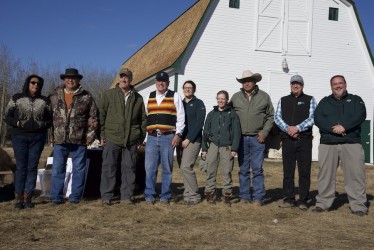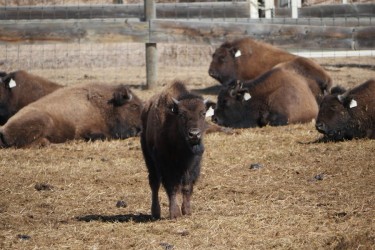Article Origin
Volume
Issue
Year
April 7, 2016.
Like many children, Paulette Fox had imaginary friends.
“I would have conversations with buffalo when I was a little girl. I thought that was silly as I got older because nobody really talked about the buffalo,” said Fox, a member of the Blood Nation, who wears many hats including mother, scientist, consultant and bureaucrat.
Photo top:
Blackfeet delegation with Parks Canada staff at Elk Island National Park.
(Photo: Parks Canada)
Photo bottom:
Bison calves made the trip south to Blackfeet Nation reserve land where they will stay until they mature enough for some to go on to other yet-to-be-determined locations.
(Photo: Parks Canada)
There was a good reason why buffalo wasn’t a common topic of discussion. The winter count of 1877 indicated there were no more buffalo on the land.
“They wanted to come home. It is the buffalo. It’s truly the buffalo. So when I think about my imaginary friends when I was a little girl, I don’t think they were so imaginary…. This is so powerful,” said Fox, voice shaking.
On April 2, Fox, who holds the Beaver Bundle along with her husband, conducted a Beaver Bundle ceremony as buffalo were transferred from Elk Island National Park to Blackfeet Nation land in Montana. The ceremony was held south of the national park on provincial crown land referred to as the Blackfoot reserve, 24 km from the Alberta-Montana border.
The Beaver Bundle is the oldest bundle in the Blackfoot traditional way of life and represents what existed pre-contact, says Fox. It represents the relationship of the people with the animals and the birds, with the water and the land.
“These bundles are shared among the whole confederacy and these buffalo coming back to the Blackfeet in Montana, they’re part of the Blackfoot confederacy,” said Fox, who noted that members from the Piikani, Siksika, and Blackfeet participated in the ceremony.
“We offered our prayers for the safe return of the buffalo,” she said. “We wanted (the buffalo) to come home to renew that spiritual link, that cultural link so that our young people could have that relationship and remember who they are and where they come from.”
Fox says the buffalo from Elk Island were unexpected and “truly a gift,” following the signing of the Buffalo Treaty in 2014 between 15 First Nations on both sides of the Canada-US border. The treaty creates an alliance among the First Nations to restore bison, conserve their land, educate their youth, and work together in economic ventures around nature and bison.
Fox sees the treaty as the “fundamental link” that Elk Island National Park needed to transfer part of its surplus buffalo herd to the Blackfoot Confederacy.
“The treaty was key to Elk Island offering this gift back,” said Fox.
“Spiritually, I thought (the treaty) was a very special thing and where the government of Canada can support such a special initiative, we’re absolutely there,” said Stephen Flemming, superintendent at Elk Island National Park. The park was not a signatory to the treaty.
The transfer of the 87 plains buffalo to the Blackfeet Nation is “incredibly special,” said Flemming, noting that some of the ancestors of these buffalo were collected from those very lands. “These animals are returning home to their ancestral lands as animals, but also returning home in the connections to the people, and the cultural significance of this return is also very special.”
When the national park’s herd – 400 plains and 400 wood bison - becomes too large, surplus buffalo are shipped to a variety of locations for conservation projects.
Before heading south, the bison were tested for disease, including tuberculosis and brucellosis, and quarantined for 60 days. Now in Montana, they are quarantined for a further 30 days. When they are released, they will stay on Blackfeet Reserve land for at least one year to mature and until other arrangements can be made for some of them.
The Wildlife Conservation Society is working with the Blackfeet Nation and the Blackfoot Confederacy through the Iinnii initiative “gradually implementing a strategy to get bison home to these lands,” said Keith Aune, director of bison program for North America. The Iinnii imitative led to the creation of the Buffalo Treaty. “In essence, the Elk Island project is a step in that strategic process to get buffalo back home to these people who have a long standing cultural, spiritual connection to bison…. We’re linking culture and conservation. We see them as inseparable.”
The Wildlife Conservation Society and the Blackfeet Nation will work together to determine the permanent home for the buffalo. One such location could be Glacier National Park, says Aune.
“The Elders told us that the buffalo never left, that it is us who are coming home. This ceremony was about praying for our people so we, ourselves, will be able to have that relationship with the buffalo because it was very traumatically removed from us,” said Fox.
“We believe our buffalo took care of us for thousands and thousands of years. And we believe that now it is time for us to take care of them. So they wanted to come home. And that’s really powerful, the belief that we had, that we’re stepping up and ready to take care of them,” said Fox.
- 6262 views


